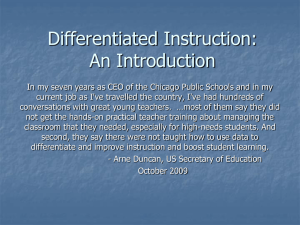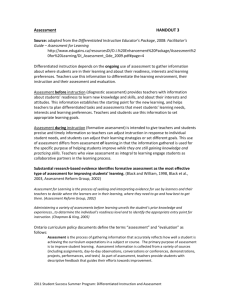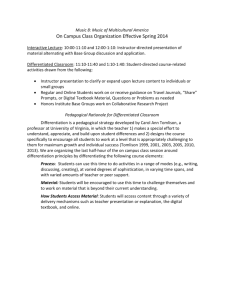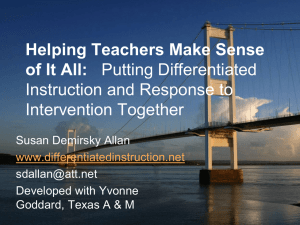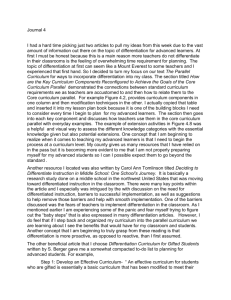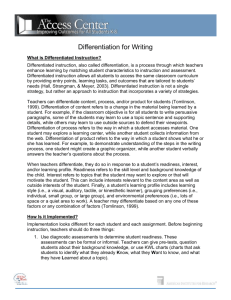Differentiated Instruction
advertisement
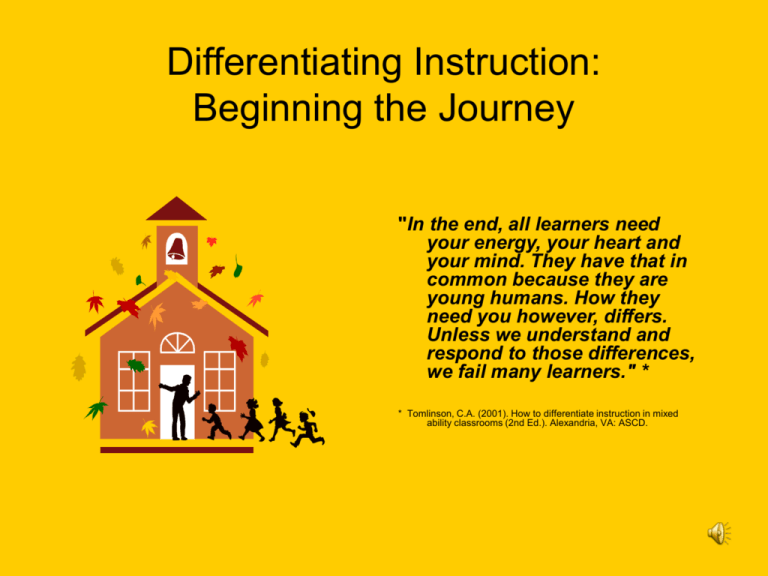
Differentiating Instruction: Beginning the Journey "In the end, all learners need your energy, your heart and your mind. They have that in common because they are young humans. How they need you however, differs. Unless we understand and respond to those differences, we fail many learners." * * Tomlinson, C.A. (2001). How to differentiate instruction in mixed ability classrooms (2nd Ed.). Alexandria, VA: ASCD. Differentiated Instruction Defined “Differentiated instruction is a teaching philosophy based on the premise that teachers should adapt instruction to student differences. Rather than marching students through the curriculum lockstep, teachers should modify their instruction to meet students’ varying readiness levels, learning preferences, and interests. Therefore, the teacher proactively plans a variety of ways to ‘get at’ and express learning.” Carol Ann Tomlinson Differentiation Is a Response to Beliefs. How Does Research Support DI? • Differentiated Instruction is the result of a synthesis of a number of educational theories and practices. • Brain research indicates that learning occurs when the learner experiences moderate challenge and relaxed alertness –readiness • Psychological research reveals that when interest is tapped, learners are more likely to find learning rewarding and become more autonomous as a learner. Key Principles of a Differentiated Classroom • The teacher is clear about what matters in subject matter. • The teacher understands, appreciates, and builds upon student differences. • Assessment and instruction are inseparable. • The teacher adjusts content, process, and product in response to student readiness, interests, and learning profile. • All students participate in respectful work. • Students and teachers are collaborators in learning. • Goals of a differentiated classroom are maximum growth and individual success. • Flexibility is the hallmark of a differentiated classroom. Differentiation of Instruction • Is a teacher’s response to learner’s needs guided by general principles of differentiation Respectful tasks Flexible grouping Clear Learning Goals Continual assessment Appropriate Degrees of Challenge Teachers Can Differentiate Through: Content Process Product Based on Student’s Readiness Interests Learning Profile Human Beings Share Common Feelings and Needs, and Schools Should Help Us Understand and Respect Those Commonalities. Individuals Also Differ Significantly as Learners; These Differences Matter In The Classroom, and Schools Should Help Us Understand and Respect These Differences. Two Views of Assessment Assessment is for: Assessment is for: Gatekeeping Nurturing Judging Guiding Right Answers Self-Reflection Control Information Comparison to others Comparison to task Use with single activities Use over multiple activities THINKING ABOUT ON-GOING ASSESSMENT STUDENT DATA SOURCES 1. 2. 3. 4. 5. 6. 7. 8. 9. 10. 11. Journal entry Short answer test Open response test Home learning Notebook Oral response Portfolio entry Exhibition Culminating product Question writing Problem solving TEACHER DATA MECHANISMS 1. 2. 3. 4. 5. 6. 7. 8. 9. 10. Anecdotal records Observation by checklist Skills checklist Class discussion Small group interaction Teacher – student conference Assessment stations Exit cards Problem posing Performance tasks and rubrics Assessment in a Differentiated Classroom • Assessment drives instruction. (Assessment information helps the teacher map next steps for varied learners and the class as a whole.) • Assessment occurs consistently as the unit begins, throughout the unit and as the unit ends. (Pre-assessment, formative and summative assessment are regular parts of the teaching/learning cycle.) • Teachers assess student readiness, interest and learning profile. • Assessments are part of “teaching for success.” Assessment in a Differentiated Classroom • Assessment MAY be differentiated. • Assessment information helps students chart and contribute to their own growth. • Assessment information is more useful to the teacher than grades. • Assessment is more focused on personal growth than on peer competition. Flexible Grouping Students are part of many different groups (and also work alone) based on the match of the task to student readiness, interest, or learning style. Flexible Grouping Sometimes students select work groups, and sometimes teachers select them. Sometimes student group assignments are purposeful and sometimes random. Flexible Grouping • Teachers may create skills – groups that are heterogeneous or homogeneous in readiness level. Change Is Imperative in Today’s Classrooms. Best Practices for Standards-based Instruction Activities and Assignments From: To: •Teacher presentation Students experiencing concepts •Whole-class instruction Centers, groups, variety •Uniform curriculum Topics by students’ needs or choice •Short-term lessons •Memorization and recall •Short responses, fill-in-theblank •Same assignments Extended activities Application and problem solving Complex responses, evaluations and writing Multiple intelligences, cognitive styles Best Practices for Standards-based Instruction Student Work and Assessment From: To: •Products for teacher / grading Products for real events / audience •No student work displayed High quality / all students •Identical, imitative products Varied and original products •Feedback = scores or grades Substantive, varied, formative feedback •Seen / scored only by teacher Public displays and performances •Teacher grade book Student-maintained portfolios, assessments •Standards set during grading Standards co-developed with students For Schools to Become What They Ought to Be, We Need Systematic Change. Planning a Focused Curriculum Means Clarity About What Students Should: Know Facts (Columbus came to the “New World” Vocabulary (voyage, scurvy) Understand Concepts (exploration, change) Principles/Generalizations (Change can be both positive and negative. Exploration results in change. People’s perspectives affect how they respond to change). Be Able to Do Skills Basic (literacy, numeracy) Thinking (analysis, evidence of reasoning, questioning) Of the Discipline (graphing/math/social studies) Planning (goal setting; use of time) Social Production These are the facts, vocabulary, dates, places, names, and examples you want students to give you. The know is massively forgettable. “Teaching facts in isolation is like trying to pump water uphill.” Carol Tomlinson Major Concepts: These are the written statements of truth, the core to the meaning(s) of the lesson(s) or unit. These are what connect the parts of a subject to the student’s life and to other subjects. It is through the understanding component of instruction that we teach our students to truly grasp the “point” of the lesson or the experience. Understandings are purposeful. They focus on the key ideas that require students to understand information and make connections while evaluating the relationships that exit within the understandings. A Student who UNDERSTANDS Something can… • • • • Explain it clearly, giving examples Use it Compare and contrast it with other concepts Relate it to other instances in the subject studies, other subjects and personal life experiences • Transfer it to unfamiliar settings • Discover the concept embedded within a novel problem A Student who UNDERSTANDS Something can… • Combine it appropriately with other understandings • Pose new problems that exemplify or embody the concept • Create analogies, models, metaphors, symbols, or pictures of the concept • Pose and answer “what-if” questions that alter variables in a problematic situation • Generate questions and hypotheses that lead to new knowledge and further inquiries • Generalize from specifics to form a concept • Use the knowledge to appropriately assess his or her performance, or that of someone else. Skills These are the basic skills of any discipline. They include the thinking skills such as analyzing, evaluating, and synthesizing. These are the skills of planning, the skills of being an independent learner, the skills of setting and following criteria, the skills of using the tools of knowledge such as adding, dividing, understanding multiple perspectives, following a timeline, calculating latitude, or following the scientific method. Change Is Difficult, Slow and Uncertain. WAYS TO DIFFERENTIATE CONTENT • Reading Partners / Reading Buddies • • • • • • • • Read/Summarize Read/Question/Answer Visual Organizer/Summarizer Parallel Reading with Teacher Prompt Choral Reading/Antiphonal Reading Flip Books Split Journals (Double Entry – Triple Entry) Books on Tape WAYS TO DIFFERENTIATE CONTENT • • • • • • • Highlights on Tape Digests/ “Cliff Notes” Note-taking Organizers Varied Texts Varied Supplementary Materials Highlighted Texts Think-Pair-Share/Preview-Midview-Postview WAYS TO DIFFERENTIATE PROCESS • Fun & Games • Cubing, Think Dots • Choices (Intelligences) • Centers • Tiered lessons • Contracts Developing a Tiered Activity 1 Select the activity organizer •concept Essential to building •generalization a framework of 2 • readiness range • interests • learning profile • talents understanding 3 Create an activity that is • interesting • high level • causes students to use key skill(s) to understand a key idea Think about your students/use assessments skills reading thinking information 4 Chart the complexity of the activity High skill/ Complexity Low skill/ complexity 5 Clone the activity along the ladder as needed to ensure challenge and success for your students, in • materials – basic to advanced • • • form of expression – from familiar to unfamiliar from personal experience to removed from personal experience equalizer 6 Match task to student based on student profile and task requirements Designing a Differentiated Learning Contract A Learning Contract has the following components 1. A Skills Component Focus is on skills-based tasks Assignments are based on pre-assessment of students’ readiness Students work at their own level and pace 2. A content component Focus is on applying, extending, or enriching key content (ideas, understandings) Requires sense making and production Assignment is based on readiness or interest 3. A Time Line Teacher sets completion date and check-in requirements Students select order of work (except for required meetings and homework) 4. The Agreement The teacher agrees to let students have freedom to plan their time Students agree to use the time responsibly Guidelines for working are spelled out Consequences for ineffective use of freedom are delineated Signatures of the teacher, student and parent (if appropriate) are placed on the agreement WAYS TO DIFFERENTIATE PRODUCT • Choices based on readiness, interest, and learning profile • Clear expectations • Timelines • Agreements • Product Guides • Rubrics • Evaluation Systematic Change Requires Both Leadership and Administration. Administrative Roles in Achieving Differentiation • Introduce all teachers to concept • Provide opportunities for training • Establish expectations • Provide opportunities for training • Provide opportunities for teachers to demonstrate and share • Provide support – resources, time, expect teachers assistance Administrative Roles in Achieving Differentiation • Encourage risk-taking • Observe and evaluate (develop tools to do this for my site’s focus) • Provide feedback • Model lessons and team teaching • Reward progress What Leaders Do Speaks with Greater Force Than What They Say. Leadership in Differentiation To be effective in using differentiation, site administrators and central office should be: Consistent: • Use vocabulary that is clear and commonly understood by the principal, the parent, the teacher • Articulate the philosophy: Kids differ. • State the expectations: all of us must g row in responsiveness. That we must change / grow / differentiate is non-negotiable; the path that we each may take is negotiable. Leadership in Differentiation Persistent: • • • • State and follow long term goals at all levels: classroom, school site, district State and follow short term goals at all levels Set time-lines so that everyone knows these goals are not going away • Provide on-going sharing of “how” • Provide on-going sharing of results throughout the school and district Leadership in Differentiation Insistent: • Require that differentiation be part of teacher plans • Require that differentiation be part of school plans • Require that differentiation be part of all staff development • Link differentiation to observations, feedback, peer review, mentoring, evaluations PRINCIPALS SUPPORTING DI • Capitalize on support from district-level administrators, curriculum supervisors or specialists, • Develop supervision techniques that motivate and recognize efforts to initiate and/or implement DI strategies • Choose professional development opportunities that provide follow-up coaching and allows time to practice new skills PRINCIPALS SUPPORTING DI • Build professional learning communities: job-embedded learning, study groups, action research, peer coaching, collaborative planning and review of student work • Effectively use faculty meetings and noninstructional time • Serve as coach: provide/receive feedback, know role vs. evaluator, coaching practices To support differentiation, leaders should • Establish clarity of definition • Provide an environment supportive of risk • Balance “seeing the light” & “feeling the heat” • Differentiate for teachers • Provide guidance in beginning sensible and progressing steadily • Provide materials and time To support differentiation, leaders should • Communicate with parents • Begin with those ready to start • Develop planning and teaching teams which routinely include regular, remedial and special ed. personnel • Start small, build local leadership To support differentiation, leaders should • Integrate differentiation into curriculum development • Maintain long term commitment to change • Provide time for on-going dialogue about differentiation – both site workdays, release time, faculty meetings The Focus of School Change Must Be Classroom Practice. In learning to differentiate, teachers may need help with . . . • A rationale for differentiation • Pre-assessing student readiness • Effective work with classroom groups • Flexible grouping • Resolving issues regarding grading / report cards In learning to differentiate, teachers may need help with . . • Role of the teacher in a differentiated classroom • Appropriate use of varied instructional strategies • Using concept-based instruction • Develop carefully focused tasks and products • Knowing how to teach struggling learners without “remedial expectations” LOOK-FORS in the Classroom • Learning experiences are based on student readiness, interest, or learning profile. • Assessment of student needs is ongoing, and tasks are adjusted based on assessment data. • All students participate in respectful work. • The teacher is primarily a coordinator of time, space, and activities rather than primarily a provider of group information. LOOK-FORS in the Classroom • Students work in a variety of groups configurations. Flexible grouping is evident. • Time use is flexible in response to student needs. • The teacher uses a variety of instructional strategies to help target instruction to student needs. • Clearly established criteria are used to help support student success. • Student strengths are emphasized There Is No Recipe, No Blueprint For Change…. A Wise Leader For School Change Is Armed With Humanity and Common Sense. The Journey Is Possible…The Complex and Uncertain Things Are Often Most Rewarding. Whatever it Takes!

